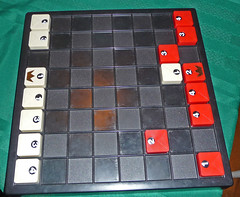 I’m not sure when my family got this game, but I remember playing with it in the late 70s. Though Shogun is described as a “digital” game, there’s no electronics involved: magnets in the board turn the dial in each piece until a number shows in the window; that number is how far the piece can move next time. The pseudo-random element takes some of the strategy out of the game1 and so it moves pretty quickly. Below you can see a rare early checkmate — most games involve a lot of piece exchanges before checkmate is on the table — that my 7 year-old managed to pull of in his third game. The numbers swinging around in the pieces is quite enchanting, especially for kids.
I’m not sure when my family got this game, but I remember playing with it in the late 70s. Though Shogun is described as a “digital” game, there’s no electronics involved: magnets in the board turn the dial in each piece until a number shows in the window; that number is how far the piece can move next time. The pseudo-random element takes some of the strategy out of the game1 and so it moves pretty quickly. Below you can see a rare early checkmate — most games involve a lot of piece exchanges before checkmate is on the table — that my 7 year-old managed to pull of in his third game. The numbers swinging around in the pieces is quite enchanting, especially for kids.
 The game seems to have been invented by a Japanese, but I’m not sure it was ever marketed in Japan. Clavell’s Shogun came out a year or so before this game did, so it’s likely that the title would have been attached to anything with a hint of Japaneseness about it.
The game seems to have been invented by a Japanese, but I’m not sure it was ever marketed in Japan. Clavell’s Shogun came out a year or so before this game did, so it’s likely that the title would have been attached to anything with a hint of Japaneseness about it.
The association of ‘Japan’ with ‘digital’ is interesting; the use of ‘digital’ itself is an interesting cultural moment, the transition from ‘transistor’ to ‘digital.’ It’s got to be early in the analog v. digital wars, and the term is clearly being misused, as this is a patently analog game. Like “Shogun,” “digital” is a marketing device intended to invoke emotional responses rather than being descriptive.
especially if you play a cutthroat version which doesn’t allow players to test moves before making them ↩